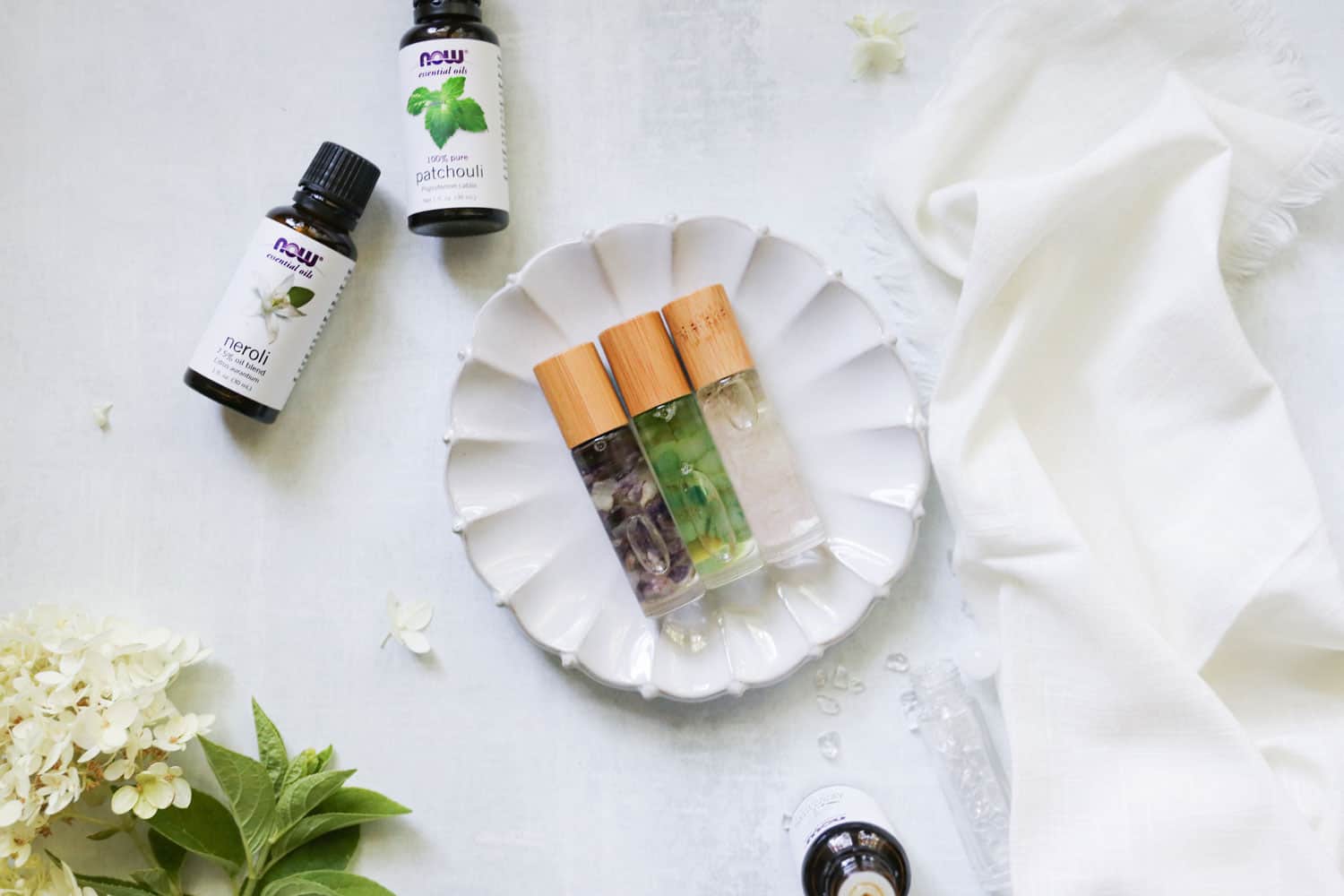
Walking through the perfume section of a department store can almost instantly trigger a headache. The scents are cloying and overwhelming. Plus, there's some nasty stuff in those commercial perfumes that you're spritzing onto your skin—chemicals you are absorbing AND inhaling.
Essential oils, especially some of the most fragrant oils like jasmine, neroli, patchouli, rose, sandalwood, and ylang-ylang, have long been used in perfume-making. But some of these essential oils are pricey, so some perfumers use cheap copycat synthetic scents instead.
How to Make Essential Oil Perfume
Creating your own perfume can take a bit of experimentation. The aromas you like may change over time. For instance, ylang-ylang was my long-time favorite, but now it can feel too heavy and overpowering at times. And patchouli used to completely scare me, but in an earthy blend, it totally works for fall.
Just know that the scents in DIY perfume are lighter wearing than those in traditional perfumes you can buy. So you don't have to worry about headaches, but you might need to apply them a little more often.
Essential Oil Scents
Essential oils typically fall into one of 7 scent categories. I personally gravitate toward soft, musky scents with a hint of floral, but there’s nothing better than playing around with different oils and taking risks. Here are some of my favorite oils in each scent category to use in homemade perfume:
1. Floral
Extracted from the plants' flowers, these sweet floral essential oils are classic scents in feminine perfumes.
—Jasmine - calming and has long been said to be an aphrodisiac.
—Ylang ylang - helps alleviate stress, improve mood and boost libido.
—Lavender - notoriously fresh and soothing.
—Neroli - helps alleviate stress, encourages circulation, and boosts mood.
2. Mint
The fresh mint aromas invigorate and improve focus.
—Spearmint - Less intense than peppermint but still cooling and energizing.
3. Musky
Essential oils in this category have earthy, musky scents that are often romantic and centering.
—Patchouli - often used in perfumes and colognes because it has a sweet, musky scent that's said to have a grounding and balancing effect on emotions.
4. Spicy
A little goes a long way with these spicy aromas.
—Ginger - a warming scent that's both energizing and stabilizing.
—Clove - a strong scent that's both spicy and woodsy, clove is soothing and comforting.
5. Sweet
Most citrus oils are in this category. Their bright, cheerful scents energize and perk you up.
—Bergamot - has a clean and refreshing citrus-y fragrance that brightens moods and calms the nerves.
—Vanilla - pure vanilla bean extract mixed with jojoba oil creates a sweet scent that's comforting and relaxing.
6. Woodsy
These earthy scents are strengthening and balancing, and they often skew masculine.
—Cedarwood - a warm, woodsy scent with slightly sedative properties, helping you relax and fall asleep more easily.
—Sandalwood - has a subtle scent that combines woodsy with a hint of floral that's said to be grounding and balancing.
7. Camphoraceous
These oils can smell quite strong, with an almost medicinal scent.
—Frankincense - a relaxing and centering scent that's often used in meditation. Its fragrance blends well with myrrh, orange, or sandalwood.
How to Blend Essential Oils
I have conflicting feelings about creating a formula using the traditional top, middle, and base note approach. Those classifications are based on how quickly a scent evaporates. I've made perfume using that method before, but to be honest, it seems overly complicated and confusing to me. And for the life of me, I cannot remember how it works or the significance of each oil.
In the aromatherapy class I took recently, we learned a different formula based on an oil's blending factor or the strength of its scent. Not to be overly dramatic, but this was kind of life-changing. It makes so much more sense to me to blend based on how strong the scent of an oil is!
How to use blending factors
Here's an example for blending the 10 drops needed for a perfume with three essential oils:
—Lime - blending factor 3
—Jasmine - blending factor 1
—Bergamot - blending factor 7
Add the blending factors together for a total of 11.
Then you take the percentage of that total (11) for each oil. For lime, it would be 3 divided by 11 (27%). Then multiply that percentage by the total number of drops you need in your recipe (10): 27% times 10 equals 2.7. So lime gets 3 drops.
—3 drops lime (3/11 x 10)
—1 drops jasmine (1/11 x 10)
—6 drops bergamot (7/11 x 10)
Total: 10 drops
You'll quickly get the hang of it after you calculate a few formulas.
My favorite essential oil perfume method
My favorite way to make perfume is with a roll-on bottle. It's easier than making a solid perfume and faster than a cologne. Plus, it makes application super easy! Simply give it a roll over your pulse points.
Therapeutic roll-on blends are all the rage right now for treating headaches, insomnia, and other ailments, but you can just as easily mix up a lovely essential oil roll-on perfume blend.
Supplies for essential oil perfume roll-on:
—Essential oils (EOs)
—Carrier oil: something light with little to no scent, like jojoba, grapeseed, or sweet almond oil
—Amber or blue 10-mL glass roll-on bottles
First, you’re going to add your essential oils to the roll-on bottle. For everyday use, put no more than 10 to 12 drops total EOs into a 10-mL glass bottle. Swirl the bottle around to thoroughly combine the oils, and then fill the rest of the bottle with a carrier oil of your choice. Replace the cap and swirl again.
Your customized perfume blend is now ready for you to enjoy! Simply apply to your pulse points and reapply as needed throughout the day. Just be sure to give the bottle a little shake before each use. Below are 12 essential oil blends to try!
12 Essential Oil Perfume Recipes
We've created 12 perfume blends that you can try, but feel free to play around with the scents that appeal to you!
Floral Perfume Blends
Jasmine and rose both have heady floral scents. To keep them from becoming overpowering, blend with almost any citrus oil. Here are five options for a lovely floral scent.
1. Jasmine Vanilla
—5 drops sweet orange
—2 drops organic lime
—2 drops jasmine absolute in jojoba oil
—2 drops vanilla in jojoba oil
2. Rose
—2 drops rose absolute
—4 drops sandalwood in jojoba oil
—5 drops bergamot
3. Enchantress
—4 drops jasmine absolute in jojoba oil
—3 drops frankincense
—3 drops sweet orange
4. Lovely Lavender
—2 drops ylang ylang
—4 drops lavender
—4 drops vanilla in jojoba
5. Flirty Floral
—2 drops clary sage
—3 drops lavender
—3 drops bergamot
—1 drop ylang ylang
—2 drops vanilla in jojoba
Citrus Perfume Blends
Citrus scents are uplifting and fresh. Roll these on when you need an energy or mood boost. If rosemary's scent brings to mind an afternoon of cleaning, try lavender or grapefruit instead.
I always hold the essential oil bottles together in my hand and waft them under my nose before blending. That way, I can see if I like a particular fragrance combo.
6. Lemon Rosemary
—5 drops lemon
—3 drops rosemary
—2 drops neroli or 4 drops sweet orange
7. Citrus Bliss
Trust me on this one—this aroma is heavenly! Every time I wear it, I get compliments!
—2 drops lemon
—3 drops lime
—5 drops vanilla in jojoba
Earthy Perfume Blends
I love rich, earthy scents. Remember, patchouli blends extremely well with many other essential oils, so you don't have to be afraid of it!
8. Patchouli Palmarosa
—3 drops patchouli
—3 drops palmarosa
—1 drop vetiver
—4 drops cedarwood
—1 drop neroli
9. Vetiver
—3 drops vetiver
—3 drops vanilla in jojoba
—4 drops sweet orange or bergamot
10. Cedarwood & Patchouli
—3 drops lime
—5 drops cedarwood
—2 drops patchouli
Spicy Perfume Blend
Clove will quickly overpower a blend, so go slow when adding it or use a pipette.
11. Bergamot Clove
—5 drops bergamot
—1 drop clove
—4 drops sandalwood in jojoba oil
—2 drops vanilla in jojoba oil
Floral & Earthy Blend
I love the combination of florals and earthy aromas—the two balance each other extremely well!
12. Sweet & Spicy
—3 drops patchouli
—2 drops ylang ylang
—5 drops lavender
More Ways to Make Perfume with Essential Oils
1. Alcohol + Water Base Perfume
My first perfume was this Citrus Sunshine perfume, and I still love the happy scent. To make your own, you'll need oil, vodka, distilled water, and your essential oils. You'll need at least 3 scents if using top, middle and base notes. (AromaWeb has a great guide for which scents are in which category.)
Start by combing a small amount of oil to find a combination you like, using 20% from top notes, 50% from middle notes, and 30% from base notes. When you find a blend you like, then you can up the ratio and dilute with the carrier oil/water. Try these spring perfume blends!
2. Solid Perfume
Solid perfume is simple to make with oil, beeswax, and essential oils for scent. I've made solid perfume batches with jasmine, sandalwood and vanilla, and lavender with shimmer. A ratio of 2 parts oil to 1 part beeswax seems to create the right consistency - hard but not too hard. You want the perfume to stay in the container and easily melt into your skin—otherwise, it feels too much like a lotion bar.
Melt your beeswax and oil together (determine the specific amounts of wax and oil based on the container you plan to use) and add 10 to 12 drops of essential oil per tablespoon of oil or beeswax mixture. Pour into a small container and let it sit until fully hardened, then it keep in your purse if you like.
3. Essential Oil Perfume Spray
This method is much like the roll-on perfume, but it's applied as a body spray. Pour carrier oil into a misting spray bottle. I like jojoba because it feels great on the skin, has a long shelf life, and doesn't have a competing scent.
For every tablespoon of jojoba oil, add about 10 drops of your essential oil blend. This can vary depending on the essential oils you use (I went way overboard on clove initially with this man-magnet spray). So start slow and add more later if needed.
You can also turn the alcohol + water perfume method into a body spray. We shared 3 summer-inspired scents here.
4. Botanic-Infused Perfume
Making an infused cologne is fun because you get to watch it develop. You can infuse dried herbs and flowers or use fresh (like in this Flower Petal Perfume) if you have extras in your garden. Above is a lavender vanilla infusion.
I used the same technique from these botanic colognes, which is basically combining herbs with vodka and letting everything sit for a couple of weeks. Then strain out the herb bits and put the liquid in a pretty container. You can layer in additional scent like you would if making perfume from essential oils if you want a stronger smell.
Essential Oil Perfume FAQs
How long does essential oil perfume scent last?
The downside of natural perfumes is that their scent tends to dissipate a lot faster than other perfumes. The scent will typically wear off after about an hour.
How can I make my essential oil perfume last longer?
Layering scents is the best way to build a strong scent for essential oil perfume. Try adding the perfume blend to the body butter and body wash that you use regularly. Also, the more places you apply the perfume, the stronger it will smell, and you can reapply throughout the day.
Where do I apply perfume oil?
Like with all perfumes, make sure to take advantage of your pulse points. These are the parts of your body where your pulse is close to the surface, and this helps to make scents stronger and last for longer. Pulse points include your neck and the inside of your wrists—the perfect places to add a little dab of your new bespoke perfume.
What's the best carrier oil to use as a perfume base?
Any carrier oil that has a neutral scent is fine; you just don't want it to compete with the essential oil fragrance. Jojoba and grapeseed oil are two of our favorites.
Are there any essential oils to avoid using?
Steer clear of oils that are known to be skin irritants, like cinnamon, oregano, thyme, nutmeg, peppermint, black pepper, and bay. And anytime you're working with essential oils, be sure to check all safety data for the oils in your blend and do a skin patch test prior to using.
This post was medically reviewed by Dr. Jennifer Haley, a board-certified dermatologist with extensive experience in medical, cosmetic, and surgical dermatology. Learn more about Hello Glow’s medical reviewers here. As always, this is not personal medical advice, and we recommend that you talk with your doctor.

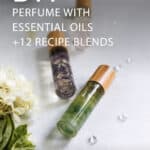
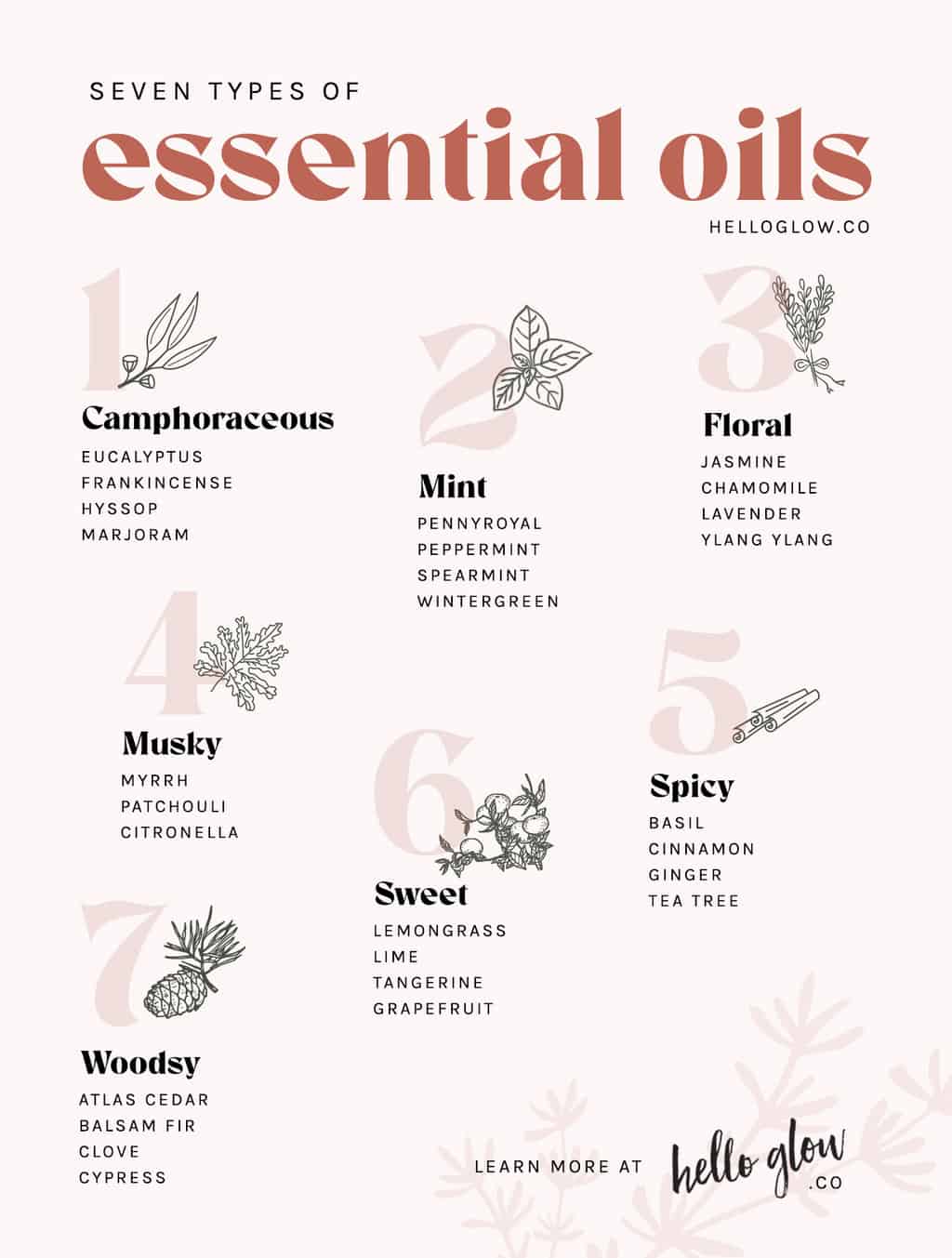


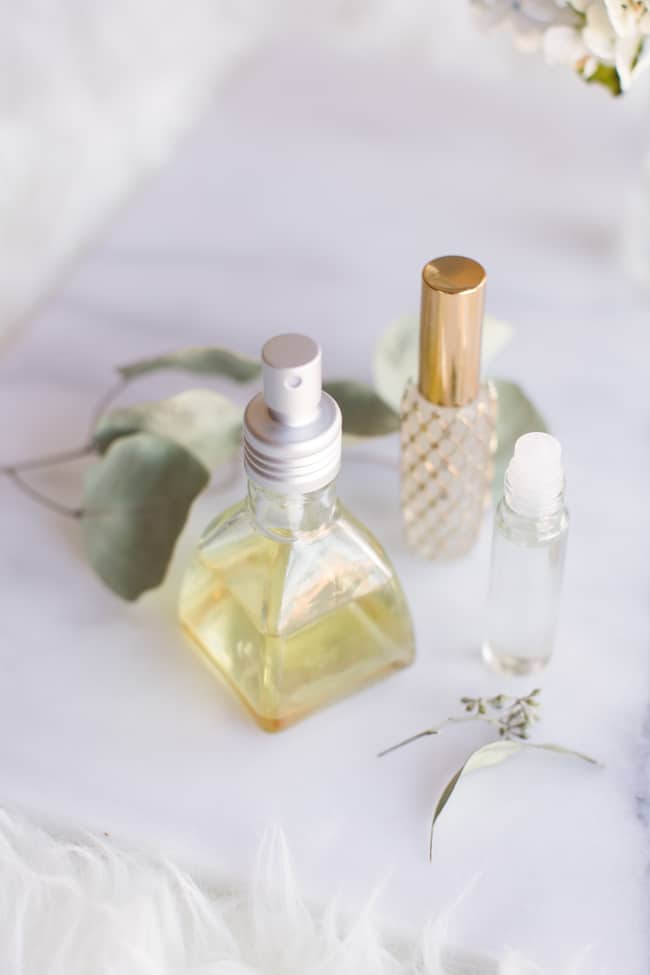
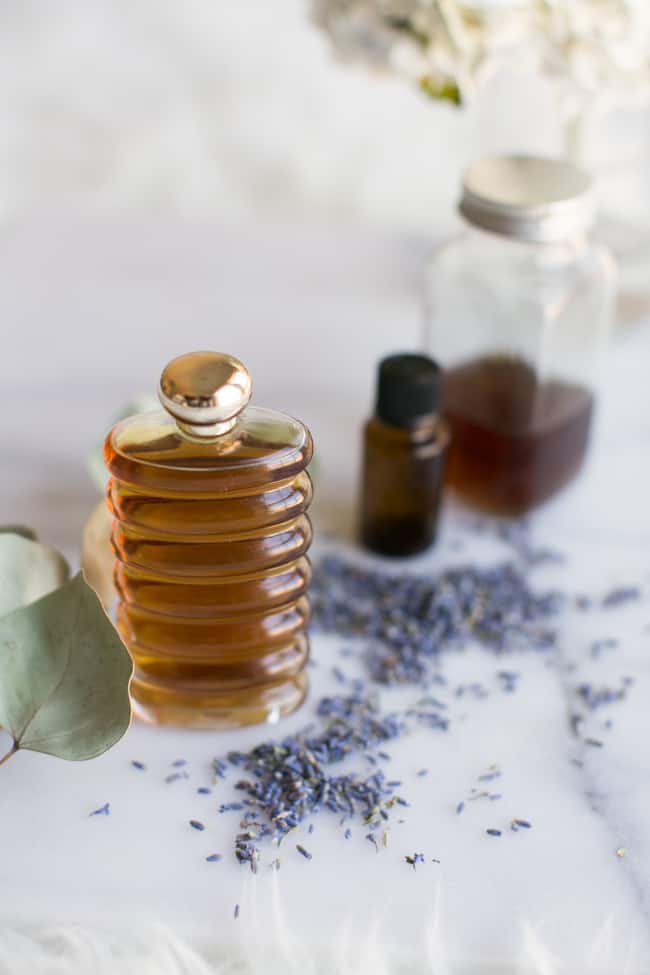
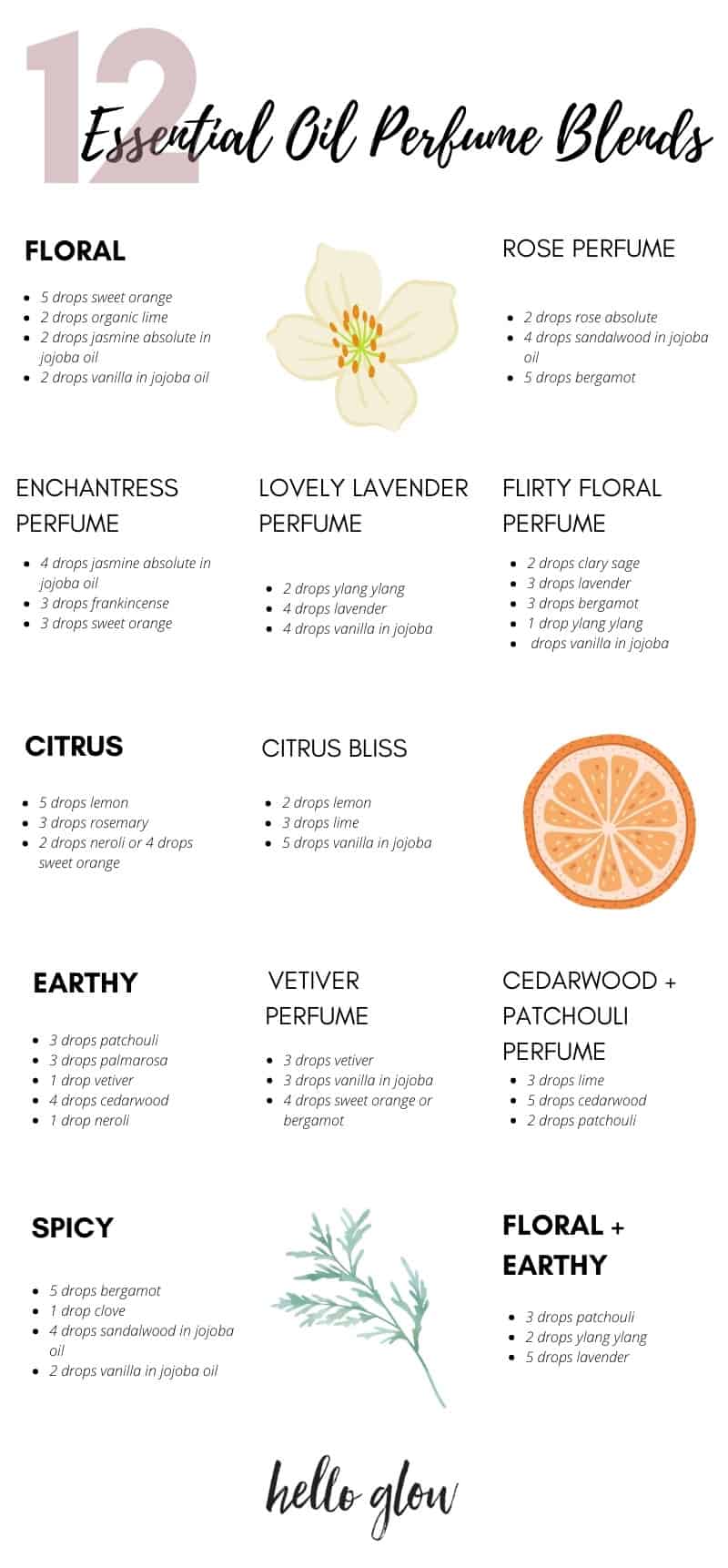
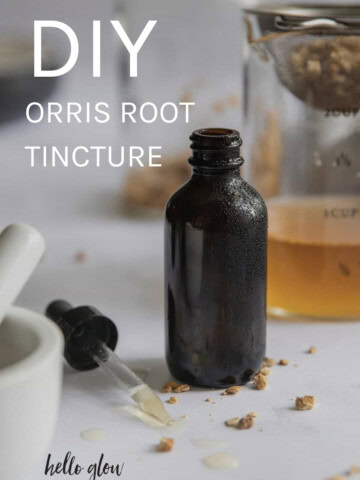

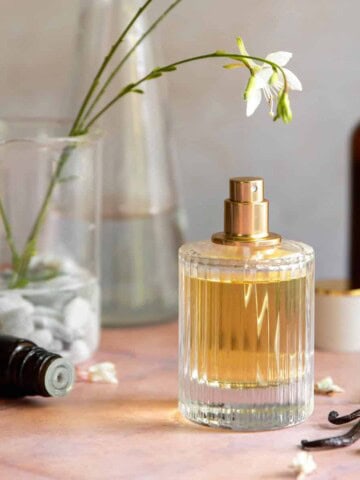
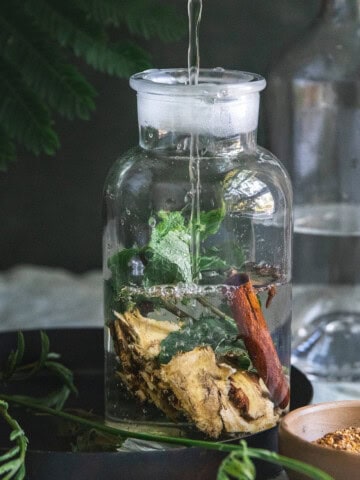
Chrissie says
I see many comments and questions on here but I nicer see the answers, advice or reply even.
Id especially like to know how you can use the blending factor of the oils, if we don’t know what each oil is on the blending factor list? Surely you should have posted or a link even to the blending chart so we know the blending factor if each oil?
Celsi Patricia Richfield says
Hi,
I'm sorry that you print the name of your products over a dark maroon colour strip, which makes them very difficult to read, sometimes impossible. Any chance of changing this?
Otherwise everything OK.
Celsi Richfield
vani says
Can we use ylang ylang, rose and lavender blend? What i am confused is , what ratio am i supposed to use these at? i do not know their blending factor, maybe if you can share blending factor chart with us, it would be helpful. Then i can apply your formula and calculate the drops needed, thanks!
Deb Pritchard says
A question. What kind of musk should I use for a roll on. I have a lotion and body wash that is patchouli, vanilla and musk and it is wonderful. They don't make a perfume/cologne so I've decided to make one myself. You have about everything else but not a musk.
Kursten says
If I am using Young Living to make a roller ball perfume, can I use their Vanilla instead of using Vanilla in Jojoba Oil?
patricia swayze says
You can buy bergamot essential oil that has the bergapten taken out and then it won't be photo-sensitive. I only use this kind when making perfume.
Charlotte says
What essential oils do you recommend for mend fragrance? and do you have any blend/combinations that you think work well?
Charlotte says
*mens
priscilla says
Hi...may i know what does it mean vanilla - 2 drops in jojoba oil?
Linda says
Plant Therapy oils have been tested and are not pure. Most oils you can find are 85-100% adulterated or synthetic, third party testing shows.
Wendy says
Can you tell me where you found that testing/data around Plant Therapy oils? Is it published anywhere? If you make a claim like that you should cite sources. Also, the article doesn't mention that brand or link to it, so your comment seems out of place (all the affiliate links are to Now Solutions and Aura Cacia).
Sarah Delia says
I'm going to have to disagree with that. Plant Therapy is one of the few reputable companies and they offer full transparency of their testing:
https://blog.planttherapy.com/blog/2019/09/30/gc-ms-testing-why-you-need-to-care/
delores says
hai, thank you for this usefull info, iam planning to make toddler perfume balm from eo, do you have any.suggestion.what aroma blend suits and save for toddler starts from 1 year age. thank.you
Aroma Expert says
Not advised to make perfume for toddlers this young. There are certain oils which are only safe to to use on young children.
V.johnfrancis says
Normally the perfumes using EO s goes well when it is not synthetic, oak moss an earthy note with ylang ylang and sweet orange smells good.
Micki says
Thanks so much! That makes a lot more sense to me too, and is more intuitive. <3
Ashley says
How do you add vanilla to your scent? What do you mean by vanilla in jojoba oil? Do you just use the vanilla you get at the grocery store?
Rissa Melton says
Can you blend Jasmine, Lavender, cedar,and sweet almond oil to make a perfume ?? Can you put some Frankincense with it ? I have a lot of medical issues, autoimmune, fibromyalgia, ADHD, very sensitive to chemicals and dye that you find in most stuff. I was raised in the mountains and was Doctored with herbs and natural stuff. " Now" I Live in west Tennessee and have all these medical issues. Doctors find me a challenge to take care of. That was until I went back to using the oils and eating like I was raised to. But I don't remember what to blend together .
Can someone please work with me on this???????
James says
Notes are relatively easy to comprehend. You would benefit greatly from understanding it. The blending factor you are using relies tremendously on the brand/quality of EO, along with how old the EO are (citrus loose their intensity between 6-12 months after opening) and the harvest conditions. Therefore, it is very unreliable.
In addition, I would not recommend Grapeseed because it absorbs too fast and it spoils (6-12 Month after opening). Jojoba has the issue of turning solid at cold temperatures. FCO (Fractioned Coconut Oil) seems like the best bet. It is not scented and last up to 4 years. However, some people can be allergic to it or Almond. In addition, some people find it a little drying on the skin, which is fine if only a small area will be applied. If you are going to use alcohol, I recommend high proof, not vodka like I have seem some blogs suggest.
Granted, quality perfume is not expected to last longer than 12 months, but I wouldn't want it to go bad after 6.
Your initial blend of Lime, Jasmine and Bergamot has several problems.
1. If the Lime EO was cold pressed it possess a danger of photosensitivity when used above 0.7%
2. If the Bergamot EO you used was not bergapten-free (FCF) vacuum out then it posses an even greater risk.
3. Lime and Bergamot are both top notes, and most of the time Jasmine is a middle note, meaning you have no base note. Your fragrance will dissipate very fast. Considering these are fragrances made entirely of EO, it is not advised that you apply every half an hour. Aside from applying base notes to your blends, try to find some that double as fixatives, they will further prolong the life of your scent by slowing down the rate of evaporation.
And most important of all, always keep safety in mind. If you are so willing to be giving out advice to your readers, then you must also assume the responsibility of only divulging safe information.
Sarah M says
To Author: Thank you for your post!!
To James: Thank you for you comment! It was helpful to me in choosing a carrier oil. I never know which to use but FCO makes a lot of sense! I really love the various uses for coconut oils/butters. Do you have any combinations of scents that you like? I am just learning how to blend.
Medhika says
Could you put this in a spray bottle?
Eleanor Marie Sweeney says
My favorite scents are jasmine and bergamot. Is there a magic ratio of drops to use for a perfume and is there a special carrier that works the best? Grape seed or jojoba or almond?
Peggy says
What if you wanted to make the solution with neutral grain spirits. How much would you add drop wise to those blends?
Hannah says
I used to have a mix made for me that was Lavender and Vanilla, I know the carrier oil was Jojoba oil, what ratio of the essential oils would I use to make it for myself?
Excel says
How does alcohol comes in all of these?
Therese Grant says
Ylang Ylang was also a long time favorite of mine. But since I noticed that I get silent headaches from it, I've stopped using it.
I'll definitely have to try out the Floral Blend. Sounds super delicious :)
Michelle says
I had the same problem with Ylang Ylang when diffusing it alone. Have you tried using it in a blend? I found when its strong floral scent was balanced out with something earthy and something citrus, it didn't have the same impact. Good luck!
Isadora Guidoni says
Thank you so much for breaking down the steps for us! I'm definitely going to make one myself =)